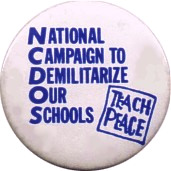
Ninth CIRCUIT COURT RULING:CONFRONTING MILITARISM BY USING EQUAL ACCESS TO HIGH SCHOOLS |

|
|||
|
When the military comes to your local high school, you have a legal right to give students an opposing view. This has been the position taken by federal district courts in Florida, Pennsylvania and Illinois and two federal appellate courts. The most broadly-worded decision came from a case that COMD took to the Ninth Circuit Court of Appeals in the 1980s. Here is the background: _____________________________________________________________ Until 1986, COMD was named the San Diego Committee Against Registration and the Draft (CARD). In 1983, CARD attempted to place anti-draft registration ads in numerous high school newspapers around San Diego County. Student journalists at most of the schools published the ads, but administrators in the Grossmont Union H.S. District banned the ads from all of its student newspapers. San Diego CARD felt it was the students’ right to decide the issue, but since they weren’t going to be given that right, we filed a lawsuit against the Grossmont district in federal district court, citing violations of our First and Fourteenth Amendment rights. We requested a preliminary injunction from the court to suspend the ad ban while we waited to see if a trial would be necessary. The district court judge in San Diego refused to issue the preliminary injunction and we appealed his decision. On June 6, 1986, the Ninth Circuit Court of Appeals issued a ruling stating that there was a substantial likelihood that San Diego CARD would have prevailed on the merits of its claim, and therefore the district court judge should have issued a preliminary injunction against Grossmont. After the Ninth Circuit issued its decision, the U.S. military attempted to convince the appellate court to rehear the case and accept the Pentagon as a co-defendant alongside the school district. The military’s goal was to ensure San Diego CARD’s defeat by applying the vast legal resources of the U.S. government. If this strategy succeeded, any decision unfavorable to the military could then be appealed to the conservative justices of the U.S. Supreme Court. Fortunately, the military’s motion to intervene in the case was turned down by the Ninth Circuit and the rehearing was denied. This left intact a major legal precedent that can be used by counter-militarism activists to demand the same opportunity to address students in public schools that is granted to recruiters and the Selective Service System. Basically, the Ninth Circuit stated that the question of military service (whether voluntary or compulsory) is a controversial political issue, and if a school establishes a forum for one side to present its views on the issue, it must give opponents equal access to the forum (download the text of the ruling here in PDF file format). While the ruling has a direct legal effect in only the nine Western states that form the Ninth Circuit, it can be used in other regions to help persuade noncooperative school districts to grant equal access to counter-recruitment activists. There have been other similar, though less encompassing, rulings in the Eleventh Circuit (Southeast U.S.) and in several cases decided at the federal district court level in Illinois, Pennsylvania and Florida. In some situations, citing these other cases can also help (contact COMD for details). Some examples of what counter-recruitment activists have been able to do in schools as a result of these court cases include:
There have also been successful efforts to counter the military’s access to student directory information (phone numbers and addresses). A cautionary note: Pursuing new lawsuits over school access today would not be a simple matter. Litigation consumes time and resources that must be diverted from organizing, and there is a high risk that a bad precedent could result. We recommend that counter-recruitment activists use the existing positive precedents whenever they would be helpful and consult with COMD if there any access problems; however, it's more effective to carefully choose initial approaches to reaching and educating students that minimize confrontation with school officials. One very useful resource for learning about such approaches is the 48-page report, "Using Equal Access to Counter Militarism in High Schools," produced by the Project on Youth and Non-Military Opportunities (Project YANO). Download it here from www.projectyano.org or order a hard copy by sending $6.50 to Project YANO, P.O. Box 230157, Encinitas, CA 92023. A complete list of Project YANO educational/organizing resources is also on the Web site. See more equal access documents here. |
||||